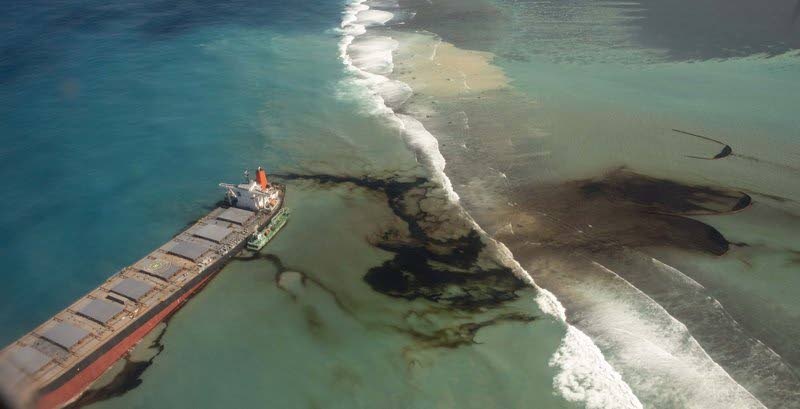Coral reefs and oil spills

As an oil- and gas-producing nation, TT must be prepared for rapid responses to spills. Coral reef ecologist Dr Anjani Ganase looks at the response to the spill in Mauritius’s pristine coral reef.
There is nothing more ominous than watching thick, black viscous oil invade transparent waters obliterating the bright colours and bustling life of a coral reef. These scenes have been observed by the Mauritians over the last month as the Japanese vessel, MV Wakashio, grounded itself on their reef. The ship carried a combination of diesel and a low sulphur-grade fuel oil, which leaked through a cracked hull.
The distresses experienced by Mauritius over the last 30 days surrounding the vessel grounding are numerous. The location of the spill is along the coral barrier reef near Point d’Esny, which is part of a complex reef system with an outer barrier reef that shelters a shallow, calm lagoon system that is home to seagrass beds, brackish water environments and mangrove ecosystems.
The ecology is similar to our Buccoo Reef marine area but about 17 times its size. Considering that the area serves as important nurseries for the fish stock and are valuable for tourism, this is a blow to the Mauritius economy. Additionally, Mauritius lacked sufficient equipment to support oil spill control on this scale and delays in the response are more devastating as weather and ocean conditions quickly spread the oil over larger areas.
The site of impact of the vessel would have undoubtedly destroyed a large section of the reef resulting in the significant loss of homes for marine organisms. Additional damage typically occurs in surrounding areas as the reef is smothered by sediment, debris, toxic fuels and other discharges from the vessel.
Much of the oil made its way across the barrier reef into the lagoon and towards the shore. It is in these very sheltered and shallow waters that the oil spill can be extremely difficult to control; and as it sits in calm pools can cause catastrophic degradation as there is a higher chance of the fuel making contact with sensitive, shallow-water habitats, the seagrass and reef. These concentrations of toxic fuels can negatively affect the physiology of the marine residents in the area. Most oil spill response plans focus efforts on preventing oil from reaching these sensitive places.
Beyond this point, the clean-up options become a trade-off between the impact of the oil itself and the impact of the clean-up activities. The use of booms to contain the oil, requires vessel manoeuvrability and the need to be anchored in place, and both are difficult to do without damaging the reef. Dispersant chemicals applied to the fuel may also be toxic to reef organisms. Lab and on-site experiments on the impact of dispersed oil on reefs range from sub-lethal impacts such as reduced health, to coral death.
There is also very limited documentation of the long-term changes to oil spill sites. Once the oil reaches the coast or intertidal areas exposed on a low tide such as shallow reefs and mangroves, the clean-up becomes even harder, as most surfaces of plants and animals that become smothered by the oil will die off. The die off in mangroves, for example, may not occur immediately but can occur years after along with limited or an extremely slow recovery period as the oil and toxins settle in the sediment and continue to cause harm. The loss of mangroves inherently leads to the loss of marine nurseries that support the fishing and tourism industries.
Fortunately, it’s not all bad news, the Mauritians were proactive in developing an 80km make-shift oil boom out of sugar cane bagasse and empty bottles to keep it afloat. The method allowed the majority of the oil to be contained until they received international assistance from France, UK and Japan which sent equipment and experts to help curtail the damage. Unfortunately, about 15 km of the adjacent coastline (this is equivalent to Pigeon Point to Plymouth) was still affected by the oil. At the wreckage site, the front section was removed and sunk in the shipping lane. The back section of the ship still remains on the reef and continues to incur damage, as bad weather conditions have restricted efforts to move it.
For now, all fishing in the area has been halted. In the coming months, clean up continues. There will be some uncertainties with regard to long-term impact to the site. The toxicity of the fuel spilled is unknown, as it is a new low sulphur-grade fuel that has never been exposed to this degree in natural environments, especially an enclosed lagoon. Intense monitoring of the water quality and the marine habitats for changes and recovery is needed to fully understand the long-term effects.
Most of us in TT, an oil and gas nation, are aware of the devastating effects of an oil spill. An oil spill disaster off the east coast of Tobago in 1979 as a result of vessel collision resulted in one of the worst oil spills to have ever occurred. Since then we are no stranger to a number of small-scale oil spills in the Gulf of Paria and around our islands.
The 2013 National Oil Spill Contingency Plan outlines the need for both wildlife rehabilitation – marine mammals, turtles and sea birds – and ecosystem restorations, which includes most of our ecologically sensitive coastal and marine ecosystems (seagrass beds, sandy beaches, coral reefs and mangrove forests) as well as special measures for deep-sea environments. It has been emphasised that the necessary response required must be within 24-48 hours of the spill with a focus to prevent the spread from coming into contact with coastal ecosystems and property.
If there is an oil spill in the marine environment, you should contact the Coast Guard for a response, while the Ministry of Energy and Energy Affairs is the agency of authority on local oil spills.


Comments
"Coral reefs and oil spills"